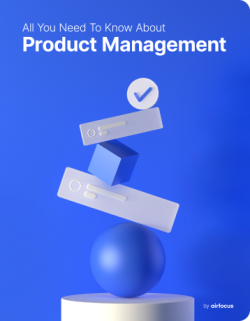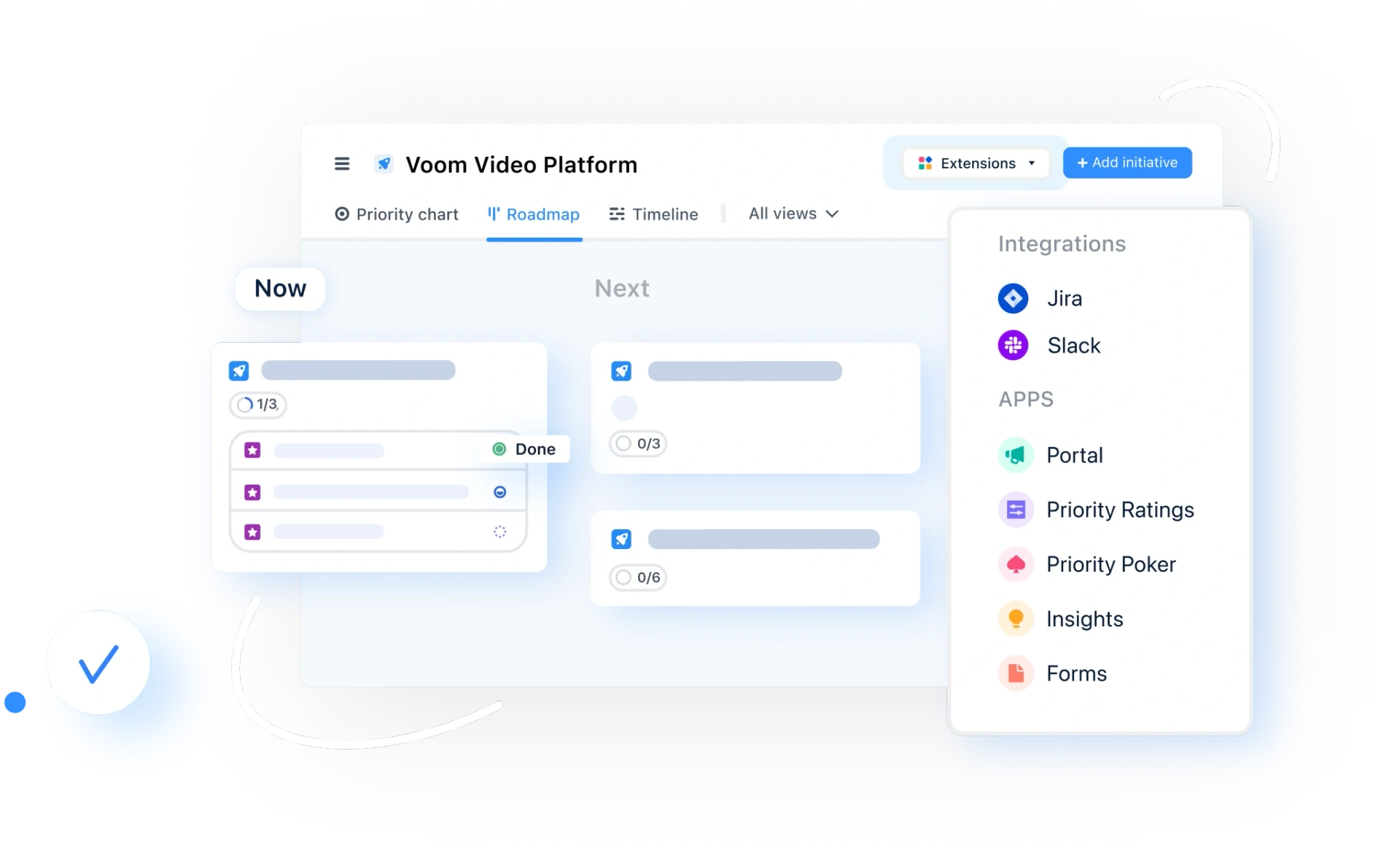The 4 Ds of Time Management
The Four Ds of time management — Delete, Delegate, Defer, and Do — offer a simple but powerful framework for product leaders managing expanding portfolios, competing priorities, and shifting stakeholder demands.
Originally developed as a personal productivity technique, the Four Ds become far more powerful when reframed as a strategic, team-level framework. When used deliberately across product organizations, they help leaders cut through the noise, align teams around what truly matters, and drive progress at scale.
This post will help you understand how the Four Ds apply in a modern product organization and how airfocus helps teams use these principles every day.
What are the 4 Ds of time management? (and why they’re still relevant in product leadership)
Definition of the 4 Ds of time management
The 4 Ds of time management are four strategies designed to help project managers make quick decisions on which tasks to act on now, later, or never.
The Four Ds of time management support clarity during roadmap planning, backlog refinement, strategic prioritization, and execution. They help leaders manage team energy and ensure that work aligns with business outcomes.
By using the Four Ds framework, product leaders can:
Maintain alignment with product strategy
Reduce internal noise and prevent focus drift
Make deliberate, value-based trade-offs across product initiatives
Put simply, the 4 Ds of time management can streamline the decision-making process and increase productivity by allocating resources strategically.
Let’s break down each part of the Four Ds framework:
Delete
Delete is prioritization in its purest form. Product leaders must constantly refine feature requests, ideas, or tasks that may be well-intentioned but don’t add value. This includes:
Saying no to customer requests that don’t align with your ideal customer profile
Removing low-impact features from the backlog
Cutting recurring rituals or meetings that no longer add value
Delegate
Delegate is about distributing decision-making power where it can be used most effectively. For product leaders overseeing multiple teams or a portfolio of products, this is essential for scaling focus and velocity.
Delegating at the team level might look like:
Empowering squad-level PMs to own discovery and delivery in specific product areas
Assigning strategic ownership of key objectives
Letting teams lead on execution without micro-management
Defer
Just because an idea is good doesn’t mean you have to use it right now. Defer is the principle of intentionally parking valuable work that isn’t urgent or strategically critical at the moment. This can include:
Pushing features into future cycles
Storing ideas in a backlog or parking lot with clear rationale
Deferring stakeholder requests with transparency and alignment
Do
Once you’ve gone through the first three Ds, the only thing left is to Do. This final stage involves high-impact execution, where tasks are carried out with clarity and purpose. For product teams, this includes:
Focusing energy on current roadmap items
Prioritizing the right tasks with a focus on dependencies
Working towards the definition of done
Why focus frameworks matter for product teams
Prioritization isn’t a one-time activity. It’s a continuous process of filtering, aligning, and adapting that helps teams focus on what really matters. The Four Ds of time management are a great way to support this, providing a focus framework that supports:
Avoiding priority dilution: The Four Ds give product leaders and teams a practical way to protect their focus. They can channel energy into the highest-impact areas by deleting, deferring, or delegating lower-value work.
Preventing reactive decision-making: Urgent requests, customer escalations, and market changes can push teams into reactive mode. The Four Ds provide a structured lens for responding with intention, rather than defaulting to “yes” or “right away.”
Creating shared expectations: The Four Ds establish a common language across teams, helping everyone understand what’s being worked on and why. This makes trade-offs explicit, creates transparency in decision-making, and builds alignment.
Applying the Four Ds framework in product management
Let’s look at how the Four Ds show up in real product workflows.
Delete
Product leaders receive a constant stream of ideas, suggestions, and feature requests, but not all of them should be included in the roadmap.
The Delete principle helps teams:
Say no to features that don’t support product goals
Remove items from the backlog that lack evidence or strategic fit
Declutter the roadmap to avoid distraction
airfocus supports deleting with customizable prioritization frameworks and Priority Poker. Product leaders can define scoring criteria, visually compare initiatives, and clearly identify what to cut. Once prioritization is complete, airfocus can help teams plot features and requests onto a product roadmap.
Delegate
As a business scales up, product leaders risk getting stretched too thin. Delegation helps leaders stay on top of everything while also improving the team’s self-sufficiency. To do this, product leaders will:
Assign ownership of metrics and outcomes to PMs or product teams
Let teams handle triage, discovery, and delivery
Provide context for decision-making
airfocus enables transparent delegation with powerful capacity management features. Leaders can see each team’s responsibilities and workload, ensuring ownership is distributed in a balanced and strategic way.
Defer
As much as we wish otherwise, there is a finite amount of time to get things done. This means not every great idea will make the cut. Deferring them ensures teams stay focused while still keeping those great ideas on deck for later. This process will involve:
Moving items to later roadmap phases
Using backlogs to hold ideas with context
Reassessing during roadmapping or quarterly planning cycles
Roadmapping in airfocus offers a way for teams to defer initiatives using visual timelines and roadmaps. This helps communicate deferred work clearly, so stakeholders stay aligned even when plans shift.
Do
Once priorities are clear, it’s time to get to work by:
Committing to high-impact initiatives
Removing any roadblocks
Staying aligned on desired outcomes airfocus’ customizable templates and workflows help teams track work, adjust plans, and maintain alignment around what’s currently being done.
Practical examples of the 4 Ds of time management at work
Let’s see how product teams apply this framework across common challenges.
Triaging customer feedback
The Four Ds provide a framework to turn customer feedback into action.
Delete feedback that doesn’t apply to your target customer or is out of scope.
Delegate ownership of analyzing and responding to the feedback.
Defer insights that align with future product plans.
Do take immediate action on clear trends or critical issues.
airfocus helps product teams capture and organize feedback, link it to features or ideas, and decide how to act on it.
Managing stakeholder requests
Stakeholders often bring in urgent ideas or last-minute demands. The Four Ds framework helps product leaders respond with clarity.
Delete requests that lack business impact or strategic alignment.
Delegate discussion or analysis to appropriate teams.
Defer requests that might be valuable later, but not now.
Do prioritize initiatives that support key objectives.
airfocus allows product leaders to connect stakeholder requests to OKRs and evaluate them alongside other work. This makes it easier to manage expectations and communicate prioritization decisions.
Deciding what makes it into the roadmap
The Four Ds provide leaders with a simple yet effective framework for structuring the roadmapping process.
Delete low-value items from consideration.
Delegate parts of roadmap ownership to product teams.
Defer initiatives that aren’t urgent but may be high value later.
Do focus execution around the most impactful and timely work.
airfocus makes this possible with flexible roadmap views and prioritization frameworks. Teams can build and adjust roadmaps collaboratively, backed by real-time scoring and evidence.
How airfocus supports focus and prioritization
The Four Ds of time management are powerful, but applying them consistently at scale can be difficult without the right tools. airfocus helps product leaders bring this framework to life by:
Providing scoring models to evaluate and rank initiatives
Offering visual roadmaps that show clear timelines and priority
Enabling capacity planning and ownership visibility
Supporting fast decision-making with templates and AI-powered insights
Every feature we put into our platform is designed to help product leaders build a more focused, aligned, and strategically grounded organization.
Help your teams focus on what matters most
airfocus helps product leaders put the Four Ds framework into action. From prioritization and roadmap planning to stakeholder alignment and capacity tracking, airfocus provides the structure and tools needed to lead with clarity at scale.
Book a demo today to see how airfocus helps you and your teams focus on what matters most.

General FAQ

Glossary categories
Experience the new way of doing product management

Experience the new way of doing product management








